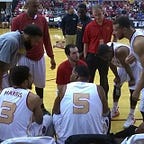“Dive”
Term: Dive
Definition: A half-court set in which one big fakes a drag and cuts down the middle while the other big lifts to set a ball-screen on the other side of the ball-handler.
Synonyms: N/A
Explanation: Any good pick-and-roll ball-handler sets up his man to get slammed by a ball-screen. Instead of waiting for the pick and maneuvering directly around it, he sheds ball pressure and forces his defender to overcommit one way. This might mean taking one or two explosive steps toward rejecting the screen, or lulling the on-ball defender to sleep by casually meandering to one side. Then, with the defender declaring a particular side, the ball-handler quickly crosses over to create separation. The ensuing distance between himself and his man makes it much easier for the screener to create solid contact.
Although many players do this instinctually, it can also be designed in organized offense. One of the ways coaches do this is through a set known as “Dive,” a ball-screen action in which the on-ball defender is pulled toward one side of the floor before getting hit with a screen on the side from which he came.
The mechanics of a Dive action are simple: One big, jogging down the middle of the floor from half-court, edges just near enough to the ball-handler to make the defense think a drag is coming. But instead of setting this transition ball-screen, he picks up his speed to cut right down the middle of the floor. Depending on whether he’s the 4 or 5, he can fan out to the three-point line or sit in the dunker spot.
As this occurs, the ball-handler wanders toward this first big as if he’s going to use the ball-screen. Whether or not the defense identifies this as an actual pick-and-roll is irrelevant; the purpose of this dummy action is just to get the on-ball defender moving his feet in one direction.
Notice how, in the Dive action below by the San Antonio Spurs, Pau Gasol at the top of the key is not even looking to set a ball-screen. He’s just sprinting right down the lane toward the dunker spot. Meanwhile, Patty Mills, the ball-handler, is inching toward that side of the floor. This brings Dennis Schroder of the Atlanta Hawks, Mills’ defender, along with him.
The nonchalant way in which Mills carries the ball to the right side makes Schroder relax. After all, Mills is no threat at 35 feet. But what Schroder doesn’t see is LaMarcus Aldrige simultaneously sprinting up the lane on the other side of Schroder and into a pick-and-roll.
When Mills suddenly flips his direction and starts darting left, Schroder is caught somewhat flat-footed. This makes it harder for him to get into the ball — one of the principles of good pick-and-roll defense — and easier for Aldridge to get a piece. On this particular play, the contact means San Antonio earns an offensive advantage and is on its way to two points.
Dive Counters
In a regular Dive play, the “diver” — the first big — isn’t involved in any meaningful way. Many teams, however, add a specific secondary action with this player to give the ball-handler more options. If the diver is an especially talented shooter, this particular action can be the set’s primary focus.
Consider again the movement of Gasol above. What if, instead of spacing out to the corner, he came off quick pindown from a guard?
Here’s an example of this from the Dallas Mavericks. At first, this looks like regular Dive action. Dirk Nowitzki heads down the lane as Nerlens Noel readies to set a ball-screen on the other side of the ball-handler, Yogi Ferrell:
For a moment, everything continues as expected. Nowitzki makes his basket cut, and Noel gets above the three-point line for a ball-screen. But as this occurs, Devin Harris quietly sneaks in from the left corner to set a screen for Nowitzki along the baseline.
This little screen is powerful for two reasons. First, take a look at Quincy Acy, in the paint and highlighted by an arrow. He’s completely lasered in on the ball, because he assumes what any player would: When a ball-screen occurs, that is the main action. Should Noel roll to the rim, Acy must position himself to tag.
Second, notice the screening inversion. Instead of a big screening for a guard, the smaller Harris looks to free the bigger Nowitzki. Given that most players know their traditional roles in screening action better than that of their positional counterparts, this creates additional defensive confusion. Not only is Acy late to react due to his focus on the ball-screen, but he is further inconvenienced by his unfamilarity chasing bigs around screens. The lack of communication between Isaiah Whitehead (Harris’ man) and Acy leaves Nowitzki open for a jumper.
As with many of the best offensive actions, there is great power in targeted simplicity. Although Dive might appear simple at first, the advantage it provides in pick-and-roll makes an already difficult task for the defense even harder. And with the additional screens that teams attach to the skeleton of the play, it is one of the tougher ball-screen actions to stop.
Film Study: “Dive”
Below is a video compilation of various examples of NBA offenses running Dive. Take note of how well the ball-handler and diver set up the ball-screen from the big sprinting up from the baseline, and pay attention to how screens added onto the end of the play impact the defensive response.
